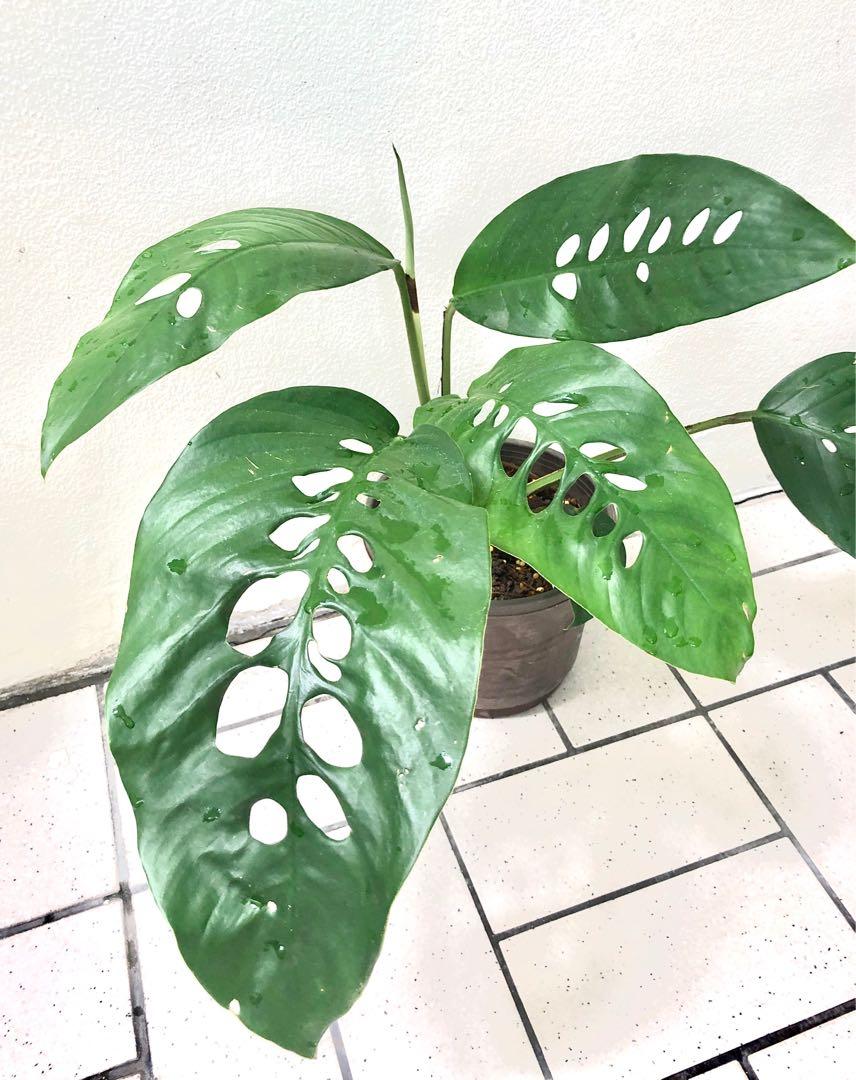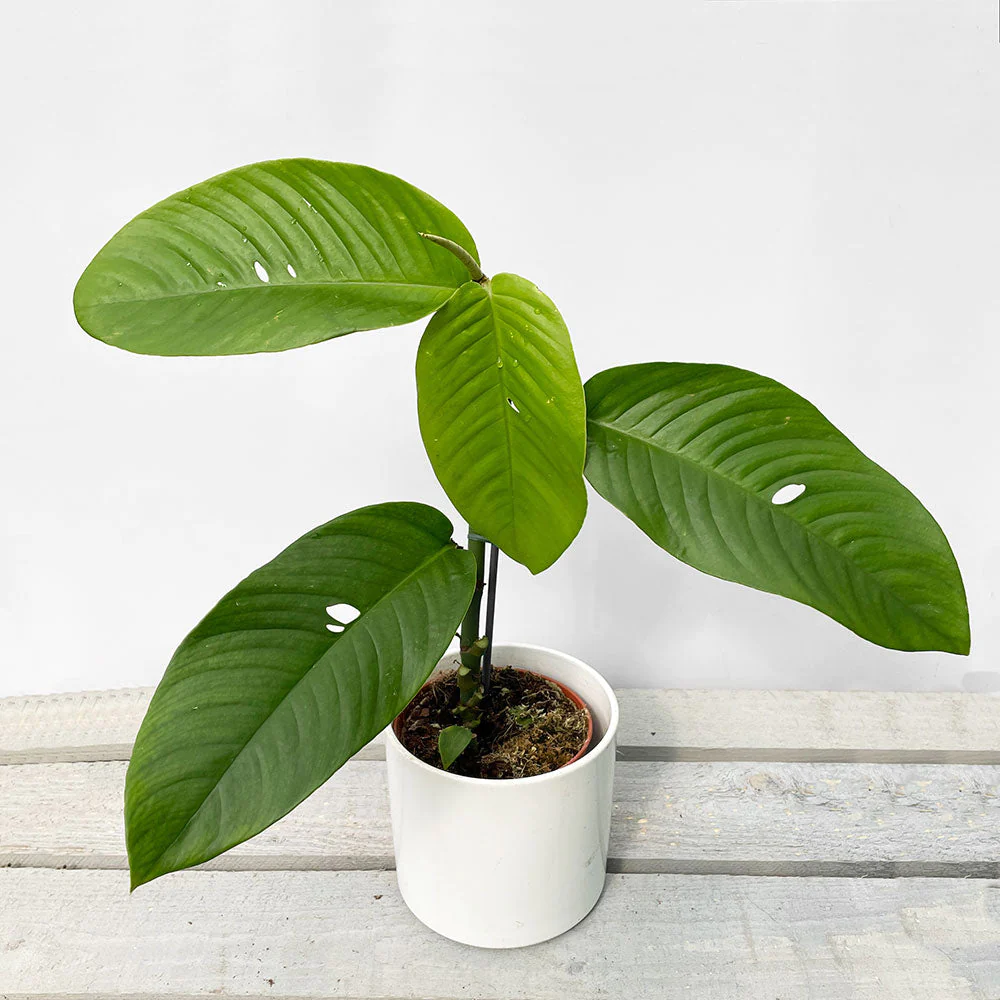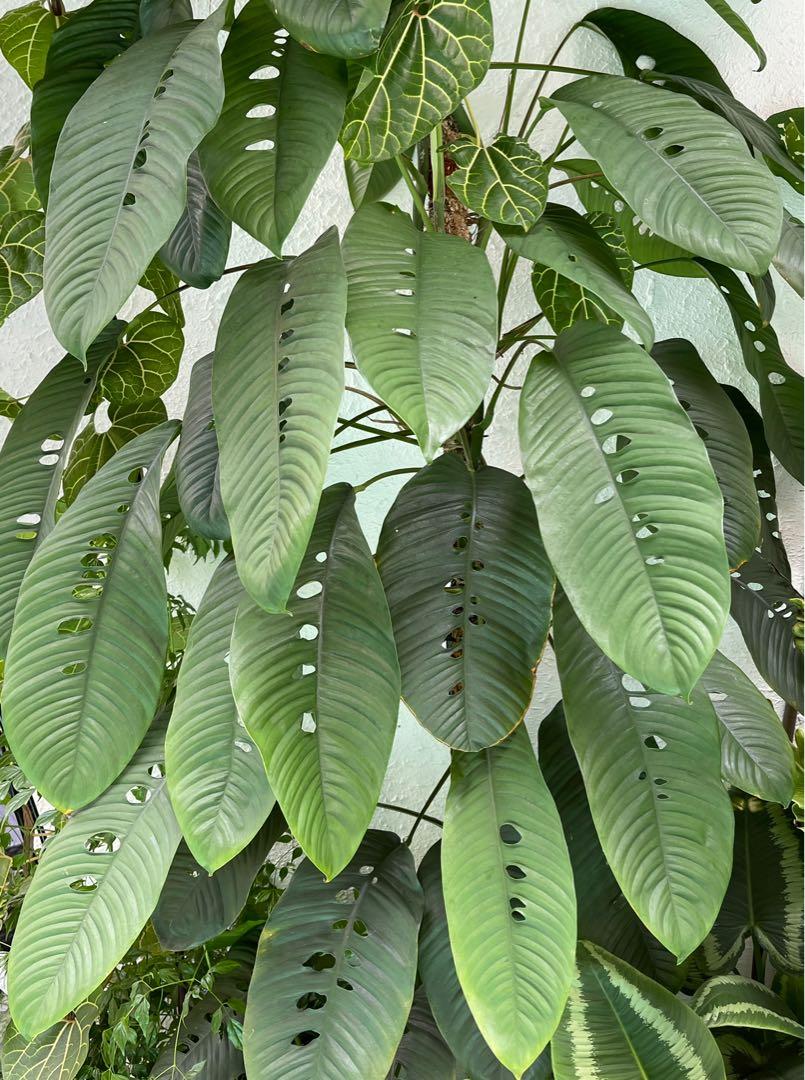Rhaphidophora foraminifera, also known as the climbing aroid or shingle plant, is a stunning tropical vine valued for its lush green foliage and vining growth habit. With its large oval leaves and aerial roots that cling to surfaces as it climbs, Rhaphidophora foraminifera makes an incredible statement plant in any indoor space. However, caring for this tropical aroid can seem intimidating to new plant parents. By following these 5 easy steps, you’ll unlock the full beauty of Rhaphidophora foraminifera in no time!

Step 1: Provide Bright, Indirect Light
As a tropical plant that would grow under the canopy of larger trees in its natural rainforest habitat, Rhaphidophora foraminifera thrives in bright, indirect light. When situating your shingle plant at home, aim for a spot near an east, west, or lightly shaded south facing window. Bright light keeps the foliage vibrantly green and powers growth. Insufficient light leads to smaller leaves and slower growth.
Finding the Sweet Spot
Pinpoint a location about 5-10 feet back from a sunny window in order to provide your Rhaphidophora foraminifera with its preferred level of bright, indirect light. If the light is too intense, the leaves will fade and bleach. Not enough light and you’ll notice smaller leaves and trailing stems struggling to climb.
Adjusting for Seasonal Changes
Take note of how the sunlight entering your space from nearby windows changes over the seasons. You may need to move your climbing aroid a bit further away from the window during intense summer light, and a bit closer during winter months when light is less intense.
“Learn more about the ideal lighting conditions for your Rhaphidophora by exploring our detailed guide on how to grow Rhaphidophora in 5 easy steps, which offers valuable insights for maintaining healthy foliage.”

Step 2: Provide a Support for Climbing Growth
With its long vining stems and aerial roots that naturally cling to tree trunks or other surfaces, Rhaphidophora foraminifera wants to climb upwards. Give your shingle plant the support it craves by providing a moss pole, trellis, or other climbing structure. This encourages healthy upward growth.
Choosing a Support Structure
Select a support structure made of natural materials that allow the shingle plant’s aerial roots to easily cling and anchor to the surface. Sphagnum moss poles that can be kept moist are perfect. Trellises or panels made of unmilled birch or bamboo also work well.
Positioning Your Support
Place the support structure close to the base of your Rhaphidophora foraminifera. As new shoots emerge, gently train these vining stems towards the support, loosely tying them in place with soft plant ties if helpful. The goal is for aerial roots to begin clinging to the support very early on for strong anchoring.
“For additional tips on supporting the climbing growth of your Rhaphidophora, refer to our comprehensive document, Discover the Fascinating World of Rhaphidophora Varieties, which includes various support structures and care methods.”

“Discover the beauty of Rhaphidophora Foraminifera today! Bring a touch of nature into your home with this stunning and unique plant. Whether you’re a seasoned plant enthusiast or a beginner, our Rhaphidophora Foraminifera is the perfect addition to your collection. Don’t miss out – order yours now and experience the joy of owning this exquisite plant.”
Step 3: Provide Consistent Moisture
As a tropical rainforest plant, Rhaphidophora foraminifera wants consistently moist (but not wet) soil at all times. Drought stress triggers leaf drop. Make watering a regular priority to unleash your shingle plant’s lushest growth.
Develop a Watering Schedule
Check the top few inches of soil daily, watering whenever it approaches dryness. Most Rhaphidophora foraminifera plants need watering about 2-3 times per week in normal household conditions. Increase frequency with brighter light or hotter temperatures. Reduce watering over winter when light and growth slow.
Choose Well-Draining Soil
Use a well-draining aroid potting mix to avoid soggy soil. Aim for a lightweight blend of peat moss or coco coir blended with orchid bark and perlite. This provides moisture retention and airflow roots need. Add sand or pumice for even better drainage if desired.
“Understanding the watering needs of your Rhaphidophora is crucial. Dive deeper into best practices with our guide 5 common reasons why your Rhaphidophora leaves are turning yellow, which includes advice on achieving the perfect moisture balance.”
Step 4: Increase Humidity
Hailing from steamy tropical rainforests, Rhaphidophora foraminifera craves high humidity levels around 60-80%. When indoor air is dry, annoying leaf tip burn and brown edges develop. Restore lushness with ample ambient moisture.
Use a Cool Mist Humidifier
Run a humidifier near your shingle plant daily to significantly boost moisture levels in the surrounding air. Refill the tank as needed to maintain higher constant humidity. Position plants out of direct path of misters to avoid leaf spotting.
Group Houseplant Together
Situate your Rhaphidophora foraminifera alongside other tropical houseplants. Grouping plants in one spot creates a little microclimate of higher natural humidity as the plants release moisture into the air. This perfectly suits the climbing aroid’s preferences.
Step 5: Apply Slow-Release Fertilizer
While low maintenance when it comes to nutrients, providing a balanced houseplant fertilizer keeps your Rhaphidophora foraminifera actively pumping out fresh new foliage. Fertilize lightly but consistently.
Fertilizer Strength & Frequency
Use half strength liquid fertilizer diluted in water every 2 weeks during active growth over spring through fall. In winter, reduce application to once per month. Alternatively, top dress soil with slow release pellet fertilizer just twice per year.
Watch for Signs of Under/Over-Feeding
If older leaves yellow and drop prematurely, increase rate of fertilizer application. Over-fertilization causes tip burn, brown edges on leaves, or poor flowering/fruiting. Flush soil to remove excess if this occurs. Finding the right balance takes some trial and error.
“For more detailed information on fertilizing your Rhaphidophora, our guide 5 Best Soil Types To Grow Rhaphidophora At Home includes recommendations on nutrient-rich soil blends and fertilization schedules.”
Conclusion
With lush tropical appeal and versatile vining growth, Rhaphidophora foraminifera makes a standout addition to modern, urban living spaces. However, unlocking the full potential of its cascading beauty is only possible when you tailor care to match its rainforest origins. Provide ample warmth, light, humidity and moisture alongside the climbing support these shingle plants crave and growth will take off beautifully. Follow these simple tips and enjoy a thriving specimen that infuses organic drama into both home and office environments.
FAQ
- What is Rhaphidophora foraminifera?
- Rhaphidophora foraminifera is a species of tropical plant known for its distinctive foliage and is a member of the Araceae family. It is often cultivated as a houseplant for its attractive appearance.
- How do I care for Rhaphidophora foraminifera indoors?
- To care for Rhaphidophora foraminifera indoors, provide it with bright, indirect light, well-draining soil, and regular watering. Keep the humidity levels up and avoid overwatering or letting the soil dry out completely.
- Is Rhaphidophora foraminifera safe for pets?
- Rhaphidophora foraminifera is generally considered non-toxic to pets, but it’s always a good practice to monitor your pets around plants and consult a veterinarian if you suspect any issues.
- What are the common pests and diseases that affect Rhaphidophora foraminifera?
- Common pests that can affect Rhaphidophora foraminifera include spider mites, mealybugs, and aphids. Diseases like root rot can also be a concern if the plant is overwatered.
- Can I propagate Rhaphidophora foraminifera, and if so, how?
- Yes, Rhaphidophora foraminifera can be propagated through stem cuttings. Simply cut a healthy stem with a few leaves and place it in a container with water or plant it in a suitable potting mix. Roots should develop, and a new plant will grow from the cutting.

